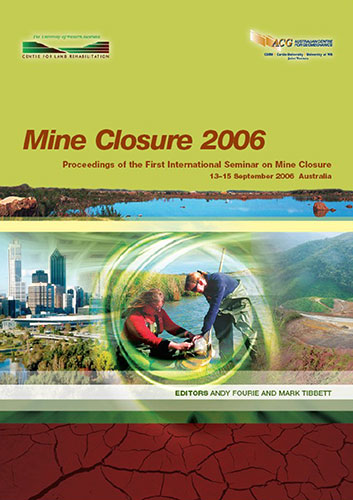Benefits of Planned Versus Unplanned Mine Closure and Strategies for Both

|
Authors: Mackenzie, S; Lacy, HWB, Koontz, D |
DOI https://doi.org/10.36487/ACG_repo/605_15
Cite As:
Mackenzie, S & Lacy, HWB, Koontz, D 2006, 'Benefits of Planned Versus Unplanned Mine Closure and Strategies for Both', in AB Fourie & M Tibbett (eds), Mine Closure 2006: Proceedings of the First International Seminar on Mine Closure, Australian Centre for Geomechanics, Perth, pp. 227-235, https://doi.org/10.36487/ACG_repo/605_15
Abstract:
The mining industry is an important contributor to local and national economies world wide and it will continue to underpin the economies of many countries in the future. Australia is one of the world’s leading exploration and mining nations. The resources sector makes a significant economic and social contribution to the Australian economy and is the nation’s largest single exporter. Australia is the world’s largest exporter of coal, iron ore, lead, diamonds and zinc, and the second largest exporter of gold and uranium (DITR, 2006). A sustainable mining industry is vital for Australia’s development. The future of the mining industry is likely to become more and more dependant on its reputation and its ability to maintain a social licence to operate. Unfortunately the reputation of the mining industry has been effected by poor examples of mine closure resulting in long-term environmental impacts and legacy sites. Current standards for mine rehabilitation and closure are much more stringent than they were even a few years ago and this reflects changing public priorities and the concept of sustainable development. Increasing public expectations for environmental protection and the increasing value of the natural environment as recreational space will continue to drive regulatory requirements and mining practice in the future. Mine closure planning has been and in many cases still is, left until near the end-of-mine life, often leaving little time, financial provision and/or resources for effective closure planning and decommissioning. This scenario is termed herewith as ‘unplanned mine closure’. Current estimates in the Australian mining industry are that the cost of prevention, through careful planning, can be one-fifth the cost of remediation at closure (Dowd, 2005). Clearly, there are significant economic considerations at stake when planning for mine closure. Developing a mine closure plan at or very near the end of mine life, can present a major hurdle to a mining company. Mine closure occurs at a time when the economic recovery of minerals has ceased, cash-flows are minimal or non-existent and material resources are often no longer accessible. This is obviously not the optimal stage to be planning and undertaking the bulk of rehabilitation and closure activities. In comparison, the benefits of progressive rehabilitation and closure (planned mine closure) are well documented but seldom are the principles adopted as a life-of-mine process. Recently, increased regulatory requirements and public interest has encouraged mining companies to consider mine closure issues during the project feasibility stage and to make on-going commitments to progressive rehabilitation and closure as part of the approvals process (DoIR, 2006).
References:
Australian and New Zealand Minerals and Energy Council and the Minerals Council of Australia. (2000) Strategic
Framework for Mine Closure.
Department of Industry, Tourism and Resources (2006) Overview, Leading Practice Sustainable Development Program.
Booklet, January 2006, Australian Government, Canberra.
Department of Industry and Resources (2006) Guideline for Preparation and Submission for Mine Approvals Section
4.7. February 2006, Perth, Western Australia.
Department of Industry and Resources (2005) Extract from Lease Tenement Conditions, Minerals Titles Online.
Dowd, P. (2005) The Business Case for Prevention of Acid Drainage. The International Network for Acid Prevention
(INAP) Conference. Keynote Speech August, 2005.
Environment Australia (2002) Mine Decommissioning - Best Practice Environmental Management in Mining.
Lacy, H. and Koontz, D. (2003) Progressive Mine Rehabilitation Systems: Taking the Static Activity of Mine Closure
into a Dynamic and Auditable System, Australian Centre for Mining Environmental Research, Adelaide, South
Australia.
Laurence, D. (2005) Optimisation of the Mine Closure Process, Journal of Cleaner Production, March 2005, pp. 1-14.
Department of Industry, Tourism and Resources (2006) Mine Closure and Completion - Draft 12, Australian
Government, Canberra.
Environmental Protection Agency (2004) A Policy Framework to Encourage Progressive Rehabilitation of Large
Mines, Brisbane, Queensland.
Environment Security (ENVSEC) (2005) Mining for Closure: Policies and Guidelines for Sustainable Mining Practice
and Closure of Mines.
Finucane, S. and Elliot, P. (2004) Key Environmental, Social and Economic Considerations in Sustainable Mining
Operations and Closure. Goldfields Environmental Management Group, Kalgoorlie, Western Australia.
Planning for Closure
Mine Closure 2006, Perth, Australia 235
© Copyright 2025, Australian Centre for Geomechanics (ACG), The University of Western Australia. All rights reserved.
View copyright/legal information
Please direct any queries or error reports to repository-acg@uwa.edu.au
View copyright/legal information
Please direct any queries or error reports to repository-acg@uwa.edu.au